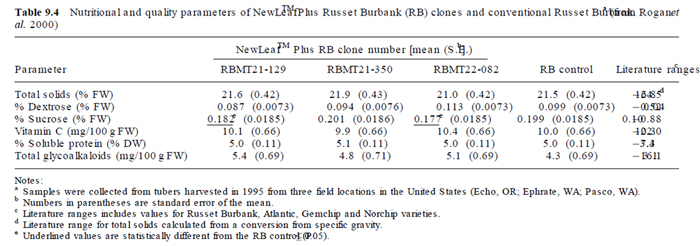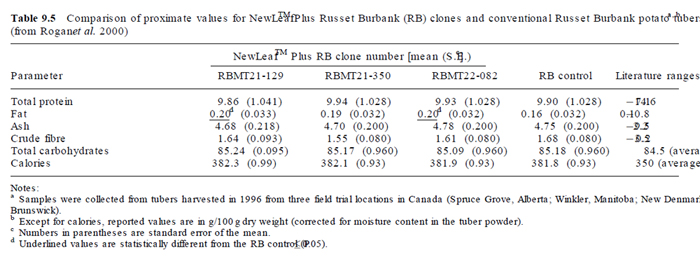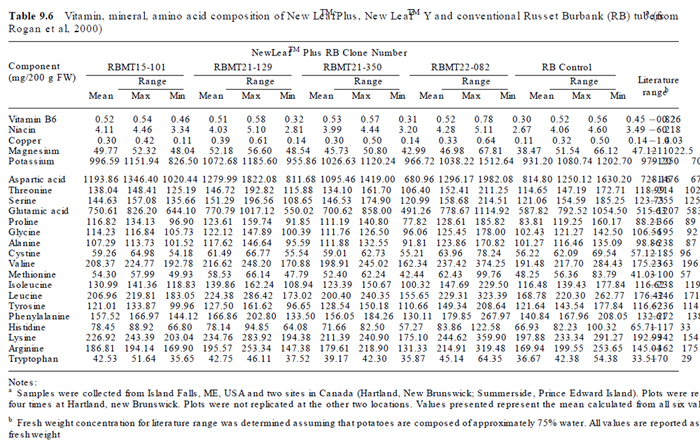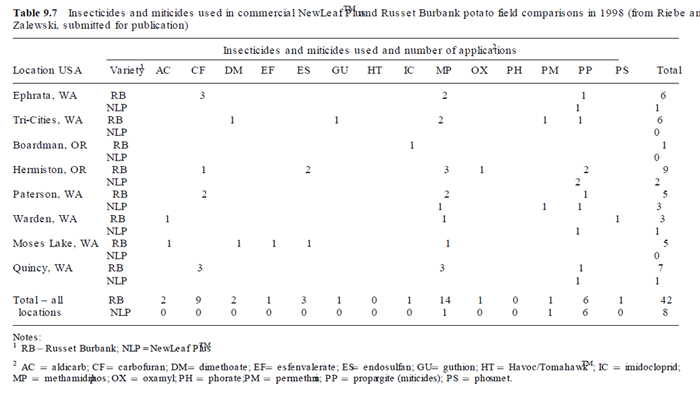Virus-resistant potato: NewLeafTM Plus and NewLeafTM Y
Virus resistance in potato has been developed using a range of approaches and
genetic constructs which include sequences of virus coat proteins, movement
proteins, replicases, untranslatable sense or antisense RNAs, proteases, defective
interfering RNAs, and satellites. Expression of ribozymes, a double stranded
RNA-specific ribonuclease, antiviral proteins, a plant pathogen resistance gene
and ‘plantibodies’ have also provided virus resistance (see Kawchuk and Prufer
(1999) for a review of approaches used to deliver virus resistance).
NewLeaf
TMPlus produced by NatureMark
® is a high yielding Russet Burbank
with combined CPB (
cry3A expression) and potato leaf roll virus (PLRV)
resistance (produced using the constitutive Figwort Mosaic Virus Promoter
(FMV) within a construct designed to prevent virus replication). PLRV can cause
yield losses of as much as 50% and nearly all commercial varieties are
susceptible to infection with world-wide losses estimated at 10% (van der Wilk
et al., 1991). PLRV also causes net necrosis (phloem cells affected), which greatly
reduces the value of tubers for fresh and processing use. Freedom from such
internal necroses provides a more consistent product and better financial returns
per hectare by reducing processing costs in French fry and chip (crisp) industries
and by helping to deliver improved seed quality. The transgenics are capable of
reducing insecticide usage by up to 100%. NewLeaf
TM Plus was approved in the
USA for consumption in August 1997. The FDA and EPA in the US determined
that the potato was as safe to eat as any other Russet Burbank. Large-scale
agronomic trials were grown in the USA in 1998.
NewLeaf
TM Y cultivars Russet Burbank and Shepody have been developed
with combined CPB and potato virus Y (PVY) resistances. PVY is considered
one of the most damaging potato viruses because it causes economically
significant yield depression. Severe infestations can reduce yield by as much as
80% (Bemster and de Boks, 1987). The PVY coat protein gene used to generate
resistance is also expressed using the FMV promoter and is more effective at
PVY control than any insecticide programme allowing more sustained crop
protection through reduced insecticide usage. Protection against PVY has
reduced seed de-certification risk for seed growers and helped to maximise
yields for commercial growers. Other benefits include improved processing
quality and storage and higher tuber set in cultivars such as Shepody (more
uniform tuber size distributions have been claimed through improved line
selections). As far as NewLeaf
TM Y is concerned the FDA and Health Canada completed their review in May 1999 and agreed they were safe for human
consumption. The EPA (August1997), USDA (February 1999) and Canadian
Food Inspection Agency (April 1999) determined that NewLeaf
TM Y poses no
concern for unreasonable effects on the environment or livestock.
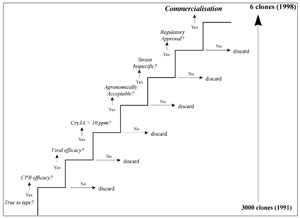
Fig. 9.1 Steps to commercialisation for NewLeafTM Plus and NewLeafTM Y CPB and virus-resistant potato clones (from Rogan et al. submitted publication).
The steps from initial clone production to the commercialisation of
NewLeaf
TM Plus and NewLeaf
TM Y is shown in Fig. 9.1. The process started
with
ca. 3,000 original clones for each with the first selection occurring after
transplanting to soil and removal of off types. True to type plants were then
subjected to a range of tests including phenotypic analysis, efficacy tests against
CPB, PLRV and PVY, susceptibility to insect, fungal and bacterial pests,
evaluation of tuber yield, tuber appearance, quality and additional extensive field
performance evaluation. Field evaluations took place over several years, in
different environments and under various agronomic conditions with emphasis on
potential environmental impact (Kaniewski and Thomas, 1999). From this process
six clones were selected for commercialisation. Rogan
et al. (2000) analysed key
nutritional, quality and anti-nutritional components of NewLeaf
TM Plus and
NewLeaf
TM Y lines to assess their substantial equivalence to the parent cultivar.
Dry matter content, vitamin C, soluble sugar, soluble protein, glycoalkaloids,
vitamin B
6, niacin, copper, magnesium, potassium, amino acids, fat, ash, calories,
total protein and crude fibre were quantified. The data confirmed that tubers
produced by insect and virus protected varieties were substantially equivalent to
tubers produced by conventional varieties(Tables 9.4, 9.5, 9.6).

Fig. 9.1 Steps to commercialisation for NewLeafTM Plus and NewLeafTM Y CPB and virus-resistant potato clones (from Rogan et al. submitted publication).
Riebe and Zalewski (submitted for publication) surveyed insecticide usage on
NewLeaf
TM Plus potatoes in paired field comparisons with conventional Russet
Burbank. The work showed that insecticide use could be greatly reduced or
eliminated with the transgenic material, providing significant environmental and
economic benefit (Tables 9.7 and 9.8). Net savingsto growers averaged $212
and $313 per hectare in 1998 and 1999, respectively. On the 140 ha monitored in
1998, NewLeaf
TM Plus allowed growers to reduce insecticides and miticides by
a total of 2,870 kg of active ingredient and 7,700 kg of formulated material as
compared with an adjacent field of conventional crop. Data indicate that more
than 500,000 kg of active ingredients could be eliminated annually in the
Columbia Basin, USA, if NewLeaf
TM Plus replaced all of the 35,000 ha of
Russet Burbank grown in the region.
| |
Table 9.8 Cost of insect control (CHEM) and damage due to net necrosis (NN) in
commercial fields of NewLeaf PluTsM and Russet Burbank in 1998 (from Riebe and
Zalewski) |
| |
|
|
|
|
Cost ($US/ha) |
| |
Location |
|
Variety |
|
CHEM1 |
|
NN2 |
|
Total |
| |
Ephrata, WA |
|
RB |
|
240 |
|
na |
|
na |
| |
|
|
NLP |
|
59 |
|
na |
|
na |
| |
Tri-Cities, WA |
|
RB |
|
161 |
|
417 |
|
578 |
| |
|
|
NLP |
|
0 |
|
22 |
|
22 |
| |
Boardman, OR |
|
RB |
|
161 |
|
141 |
|
302 |
| |
|
|
NLP |
|
0 |
|
0 |
|
0 |
| |
Hermiston, OR |
|
RB |
|
489 |
|
27 |
|
516 |
| |
|
|
NLP |
|
116 |
|
17 |
|
133 |
| |
Paterson, WA |
|
RB |
|
388 |
|
119 |
|
507 |
| |
|
|
NLP |
|
133 |
|
0 |
|
133 |
| |
Warden, WA |
|
RB |
|
237 |
|
49 |
|
286 |
| |
|
|
NLP |
|
59 |
|
0 |
|
59 |
| |
Moses Lake, WA |
|
RB |
|
287 |
|
0 |
|
287 |
| |
|
|
NLP |
|
0 |
|
0 |
|
0 |
| |
Quincy, WA |
|
RB |
|
289 |
|
0 |
|
289 |
| |
|
|
NLP |
|
59 |
|
32 |
|
91 |
| |
Average all locations3 |
|
RB |
|
281 |
|
108 |
|
389 |
| |
|
|
NLP |
|
53* |
|
10 |
|
63* |
| |
Notes:
1 Actual cost of all applied insecticides; NLP trait premium not included.
2 Net necrosis cost estimated from USDA grade deductions using the formula:
(% by weight damaged × $0.33/mt) + (% unusable × $1.00/mt) × 56 mt/ha.
3 NLP averages followed by an asterisk are significantly different from RB (P < 0.05). |


